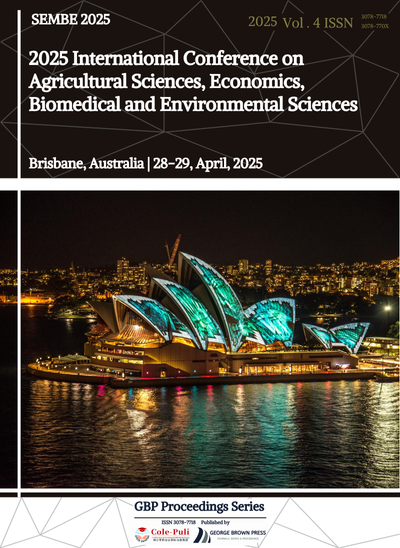Response of Pepper Growth to Water Deficit in a Cold and Arid Environment
DOI:
https://doi.org/10.71222/5z741271Keywords:
water deficit, pepper, plant height, stem diameter, leaf area index, dry matter accumulation, root-shoot ratioAbstract
To assess the response of chilli growth and dry matter to water deficit in sub-film drip irrigation, a field experiment was conducted in a cold and arid region of Northwest China in 2016. The experiment was designed with three water deficit (WD) levels: mild deficit (65%-75% in the field capacity, FC), medium deficit (55%-65% in FC) and severe (45%-55% in FC). Water deficit treatments were applied during the seedling, flowering and fruiting, full fruiting, and later fruiting stages. Full irrigation (75%-85% of field capacity) throughout the entire growing season was used as the control (CK). The results showed that different WD at seedling, flowering and fruiting, and full fruit of pepper significantly (P < 0.05) decreased plant height, stem diameter and leaf area index than CK. WD applied either at the seedling stage or during the flowering and fruiting stage decreased the above-ground biomass and root mass. Additionally, the reduction in aboveground biomass and root mass became more significant as the severity of WD increased.
References
1. Z. Zou and X. Zou, "Geographical and ecological differences in pepper cultivation and consumption in China," Front. Nutr., vol. 8, p. 718517, 2021, doi: 10.3389/fnut.2021.718517.
2. H. Wang, C. Liu, and L. Zhang, "Water-saving agriculture in China: an overview," Adv. Agron., vol. 75, pp. 135–171, 2002, doi: 10.1016/S0065-2113(02)75004-9.
3. L. Zhao, L. Zhang, N. Cui, C. Liang, and Y. Feng, "The evaluation of regional water-saving irrigation development level in humid regions of Southern China," Water, vol. 11, no. 1, p. 172, 2019, doi: 10.3390/w11010172.
4. C. Stanghellini, F. L. K. Kempkes, and P. Knies, "Enhancing environmental quality in agricultural systems," Acta Hortic., vol. 609, pp. 277–283, Jul. 2003, doi: 10.17660/ActaHortic.2003.609.41.
5. H. G. Jones, "Irrigation scheduling: advantages and pitfalls of plant-based methods," J. Exp. Bot., vol. 55, no. 407, pp. 2427–2436, 2004, doi: 10.1093/jxb/erh213.
6. H. Kirnak and M. N. Demirtas, "Effects of different irrigation regimes and mulches on yield and macronutrition levels of drip-irrigated cucumber under open field conditions," J. Plant Nutr., vol. 29, no. 9, pp. 1675–1690, 2006, doi: 10.1080/01904160600851619.
7. I. Goodwin and A. M. Boland, "Scheduling deficit irrigation of fruit trees for optimizing water use efficiency," in Deficit Irrigation Practices, 2002. ISBN: 9251047685.
8. S. Kang and J. Zhang, "Controlled alternate partial root-zone irrigation: its physiological consequences and impact on water use efficiency," J. Exp. Bot., vol. 55, no. 407, pp. 2437–2446, 2004, doi: 10.1093/jxb/erh249.
9. B. A. Bravdo, "Physiological mechanisms involved in the production of non-hydraulic root signals by partial rootzone dry-ing—A review," in VII Int. Symp. Grapevine Physiol. Biotechnol., Acta Hortic., vol. 689, pp. 267–276, Jun. 2005, doi: 10.17660/ActaHortic.2005.689.31.
10. E. Fereres and M. A. Soriano, "Deficit irrigation for reducing agricultural water use," J. Exp. Bot., vol. 58, no. 2, pp. 147–159, 2007, doi: 10.1093/jxb/erl165.
11. M. Celebi, "The effects of water stress on yield performance of drip-irrigated pepper (Capsicum annum L. cv. Capya var. Yalova yağlık 28) in the Central Anatolian region of Turkey," Arab. J. Geosci., vol. 11, no. 23, p. 758, 2018, doi: 10.1007/s12517-018-4086-1.
12. A. M. Boland, P. D. Mitchell, P. H. Jerie, and I. Goodwin, "The effect of regulated deficit irrigation on tree water use and growth of peach," J. Hortic. Sci., vol. 68, no. 2, pp. 261–274, 1993, doi: 10.1080/00221589.1993.11516351.
13. T. Mahmood, R. M. Rana, S. Ahmar, S. Saeed, A. Gulzar, M. A. Khan, F. M. Wattoo, X. Wang, F. Branca, F. Mora-Poblete, et al., "Effect of drought stress on capsaicin and antioxidant contents in pepper genotypes at reproductive stage," Plants, vol. 10, no. 7, p. 1286, 2021, doi: 10.3390/plants10071286.











